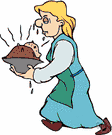scrap 1
(skrăp)n.
1. A small piece or bit; a fragment.
2. scraps Leftover bits of food.
3. Discarded waste material, especially metal suitable for reprocessing.
4. scraps Crisp pieces of rendered animal fat; cracklings.
tr.v. scrapped, scrap·ping, scraps
1. To break down into parts for disposal or salvage: scrap an old stove.
2. To discard or abandon as useless; cancel: scrap a plan.
scrap 2
(skrăp)intr.v. scrapped, scrap·ping, scraps
To fight, usually with the fists.
n.
A fight or scuffle. See Synonyms at brawl.
[Perhaps variant of scrape.]
scrap′per n.
American Heritage® Dictionary of the English Language, Fifth Edition. Copyright © 2016 by Houghton Mifflin Harcourt Publishing Company. Published by Houghton Mifflin Harcourt Publishing Company. All rights reserved.
ThesaurusAntonymsRelated WordsSynonymsLegend:
| Noun | 1. |  scraps - food that is discarded (as from a kitchen) scraps - food that is discarded (as from a kitchen)waste, waste material, waste matter, waste product - any materials unused and rejected as worthless or unwanted; "they collect the waste once a week"; "much of the waste material is carried off in the sewers" |
Based on WordNet 3.0, Farlex clipart collection. © 2003-2012 Princeton University, Farlex Inc.